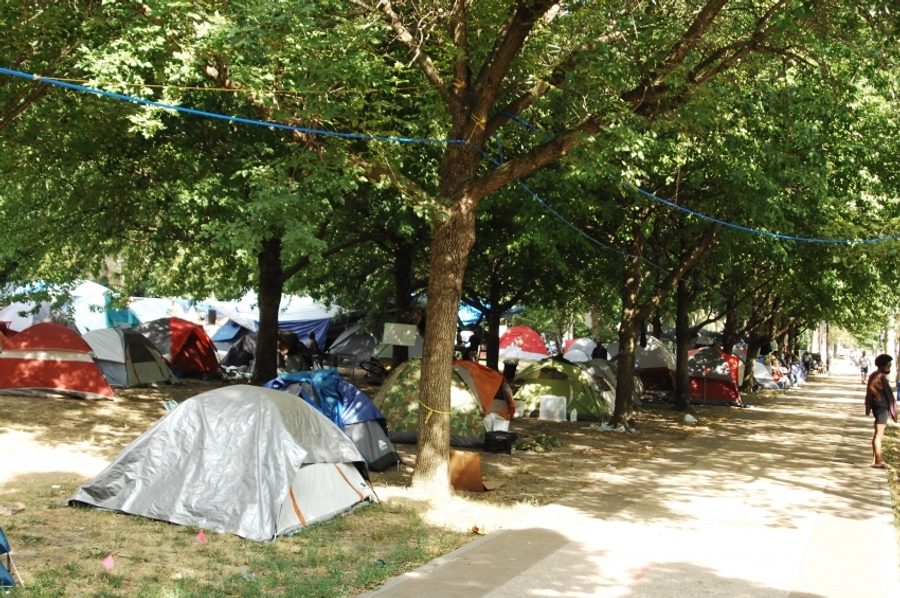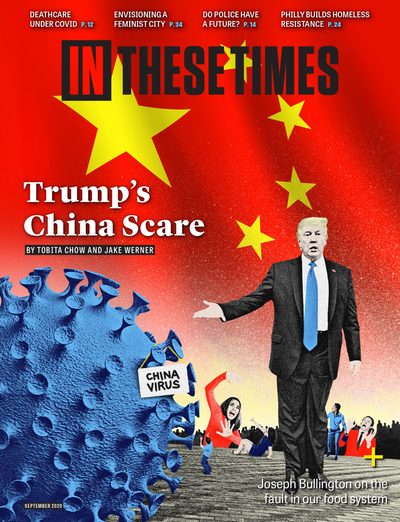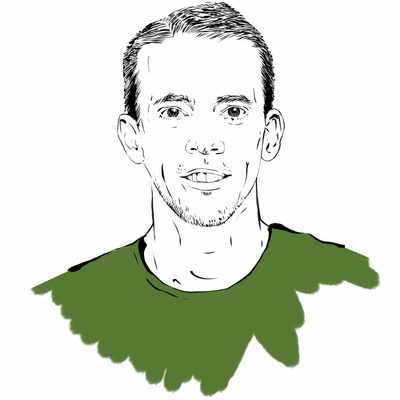The Future of Homeless Organizing Lives on the Prettiest Street in Philadelphia
Hamilton Nolan

In the beginning, they called it “Camp Maroon,” harking back to remote communities built by formerly enslaved people who ran away from their captors. Then it was called James Talib-Dean Camp, named after one of its organizers who passed away in June. Then it was called Lakay Nou, meaning “our home” in Haitian Creole. To many in Philadelphia, it’s simply known as the encampment on 22nd Street and Benjamin Franklin Parkway, stretching a full block down the handsome, leafy avenue leading up to the Philadelphia Museum of Art. You could also call it an inspiration.
Lakay Nou began June 10 with just five tents. In days, it became 50, then 100. After two weeks, there were well over 100 tents, hosting what organizers say is more than 200 residents. There are now handwashing stations, fed by a skinny blue hose plugged into a nearby water fountain and strung overhead through trees. There are showers. There is a medical tent. There is free Covid-19 testing every Monday. There is a kitchen. There is a charging station, accompanied by the constant hum of several generators. There is an ad hoc security force, made up of residents. There are free supplies for bedding and cleaning and personal hygiene and personal protective equipment. There is a donation tent, a garden and — on the fence of an adjacent baseball field — a big white canvas hung as a screen for regular movie nights. Where there was once just empty grass, there is now something approaching community.
Beyond the immediate impact of this enormous encampment — the shelter and safety and resources that it provides to vulnerable people at a vulnerable time — one of its most notable qualities is that it was conjured up completely outside of what critics call the “nonprofit industrial complex,” a system held in contempt by the camp’s organizers.
“You’ve got people saying they’ve been ‘working in homelessness’ for 20 years,” Alex Stewart says derisively. He is sitting on a long bench one hot day in June, in the midst of the camp he helped create. “That only benefits them. Because homelessness is a problem that shouldn’t exist for 20 years.”
Stewart, one of the lead organizers, is a founder of the group Workers Revolutionary Collective. (James Talib-Dean Campbell, who died after the camp was built, was another.) Stewart has worked for nonprofits himself, but grew disgusted by what he saw as their self-serving nature, as employees took home healthy salaries while the people they were supposedly helping remained in crisis. The encampment is a manifestation of the “just do it” approach to organizing: See a problem, do something, cut out the middlemen.
Still, the encampment did not spring up from nothing. Its success is a product of months of work on the underlying issues by many of the people who put it together. “We’ve all been doing this work separately,” says Sterling Johnson, a Philadelphia activist who helped organize the camp. “We really have values in line with each other. The people’s economy, being anti-racist, wanting to center the people who have been through some things. Everybody in these groups have been through some trauma.”
The majority of the residents and the organizers of the camp are Black people, acting with a sense of strategic desperation during a time of crisis. Earlier this year, Stewart and others began offering meals to homeless people in the city several times a week, just to build relationships. The same group of activists helped homeless people quietly move into vacant, city-owned houses. (Stewart says they have housed 50 people this year, and that he has scouted 500 vacant homes.) That work gave them both the credibility and the contacts to pull off the audacious encampment that has now risen along the city’s most prominent thoroughfare.

Organizers stress that camp residents are leading its development, many of whom are sympathetic with the Black Lives Matter movement (Cory Clark/NurPhoto via Getty Images)
All of the organizers stress that the residents are the ones who came up with the idea of the camp — and are leading it. Volunteers help run the medical tent, and donations pour in from the community at large, but there is no outside institution supporting the encampment. “The homeless are organizers,” says Tara Taylor, an organizer and resident of the camp. “They know their communities. It’s their word of mouth and their community connections that allowed the camp to grow.”
And grow it has. Everyone I spoke with at the camp says they heard about it within its first few days, by word of mouth. George, a 47-year-old man who had been staying in a tent on Parkway for two weeks, says life on the streets of Philadelphia got noticeably harder because of the coronavirus: Stores and other businesses shut down, downtown emptied out and the center of the city was left with homeless residents and little else.
“You don’t have that many opportunities,” George says. “Every place is locked down. You don’t have much to work with. Plus, you’re more susceptible to catching [Covid-19] than anybody.” He says the encampment is preferable to life before, but when asked whether he would be satisfied to be left alone there, he scoffs, “Hell, no! I don’t want to stay out in a tent.”
Although he receives a monthly disability check, he says he has been told the wait for public housing is seven years long.
Permanent housing is what the people want. Permanent housing is what they need. And permanent housing is at the heart of the demands posted at the camp. They ask for a community land trust of vacant properties for conversion to low-income housing; a moratorium on the sale of city-owned properties to private developers, until everyone in the city is housed; an end to the city’s sweeps (or “resolutions”) of homeless people and encampments; more tiny houses, paid for with public funds; and for the Parkway encampment to be allowed to remain as an autonomous zone, without intrusion from police.
Though the city of Philadelphia has not shut down the camp (as of the end of July), it is clear that may soon change, demands notwithstanding. Mike Dunn, a spokesperson for the city, said July 7, “We have been negotiating with the leaders of the camp for the past several weeks to try to arrive at a cooperative resolution in which the camp disbands voluntarily by mid-July and everyone there has a plan.” He added, “We have also let the leaders of the camp know that it cannot go on indefinitely. We are prepared to impose a timeline this week if needed. We are prepared to offer the services that people need and want and to use this situation as a starting point for reforms that will take longer to achieve.” In fact, organizers rallied supporters and publicity to resist a rumored July 17 move by the city to clear them out. The day came and went, and the camp remained.
Still, the residents of the Parkway encampment are in a tenuous position, considering the fact that one of the camp’s defining characteristics from the beginning has been its self-reliance — premised on its rejection of both assistance and meddling from the city or from established nonprofits. Alex Stewart says, for the first two days, the camp allowed outreach workers to come in. “The only thing they offered people was granola bars and water,” he says. “We have plenty of that. They couldn’t offer shelter.”
Tara Taylor echoes that sentiment. “It’s not because we don’t want the services,” she says. “It’s because the services being offered aren’t sufficient, they aren’t rendered in a way that’s humane, and folks don’t want to be gaslighted that this is supposed to help them, when it’s not.”

The right to exist without harassment from police and the right to permanent housing are among the demands of camp residents. (Cory Clark/NurPhoto via Getty Images)
To be fair, the scale of homelessness in major U.S. cities exceeds the ability of most city governments to do much about it without significant federal help. It is a problem that affects not just those already living on the streets, but a much larger group of low-income workers who have seen the affordability of cities decline drastically over the past two decades and who now find themselves perpetually just one unlucky month away from losing their housing. According to the National Low Income Housing Coalition, there are only 29 affordable housing units for every 100 very low-income households in the Philadelphia area, and three-quarters of very low-income households are classified as “severely” cost-burdened, meaning they spend more than half their income on housing. Until affordable housing construction measures units in the tens of thousands, the city will continue to play host to a large pool of residents who know they could realistically wind up homeless with few options for rescue.
America is in the midst of a pandemic and a global economic catastrophe. Millions have become unemployed through no fault of their own. The emergency eviction moratoriums that were put in place after the coronavirus struck are already expiring, and the emergency federal unemployment payments that have kept countless people afloat expired in late July, with Congress still debating their renewal. We are at the precipice of a nationwide eviction crisis with no real plan. The concrete achievement in Philadelphia — the creation and maintenance of a camp with tangible resources for hundreds of a city’s most vulnerable and needy people — is not a full remedy for homelessness, but it is an example of what a handful of dedicated, radical people can do in the midst of what feels like allencompassing decay of our social safety net. As much as we are living through chaos, we are also living in a time of opportunity for activists everywhere.
Adam Gottlieb, an activist and an organizer around homelessness in Chicago, says the pandemic has made the day-to-day work of homeless outreach much more difficult. “It’s really hard to practice any form of public health safety protocols under these conditions,” he says. “ ‘Shelter in place,’ by definition, requires shelter. It’s a non-starter for people living on the streets.”
Still, he agrees the ongoing crises have made conditions “much more favorable” to radical social justice organizing of all stripes. The Black Lives Matter uprisings have inspired many activists to be bold. Gottlieb sees the Philadelphia encampment’s militant commitment to self-sufficiency and its prickliness about outside control as a reaction against universal problems with how ostensibly helpful institutions often treat the homeless.
“They end up relating to people as powerless victims who can’t do anything for themselves,” he says. “It becomes a destructive spiral.”
The activists in Philadelphia say they are determined to avoid that trap. But the city’s patience with their experiment is running short. For now, the community survives. And the people in it, who are not usually given control of their own lives, have at least one more day at Lakay Nou.
During the sunny midday hours in June, a tall, skinny young man named Don sits down on a bench on the side of Parkway, a block away from the encampment, where he has been staying. He says he is looking for God, but all the churches are closed. He wears a disposable paper mask over another cloth mask. He sits out here as time passes slowly.
“Imagine you’re a fish,” he says, “and coronavirus is the bowl. And God puts you in the bowl. Now, how are you gonna feel? Trapped.”
Hamilton Nolan is a labor writer for In These Times. He has spent the past decade writing about labor and politics for Gawker, Splinter, The Guardian, and elsewhere. More of his work is on Substack.









